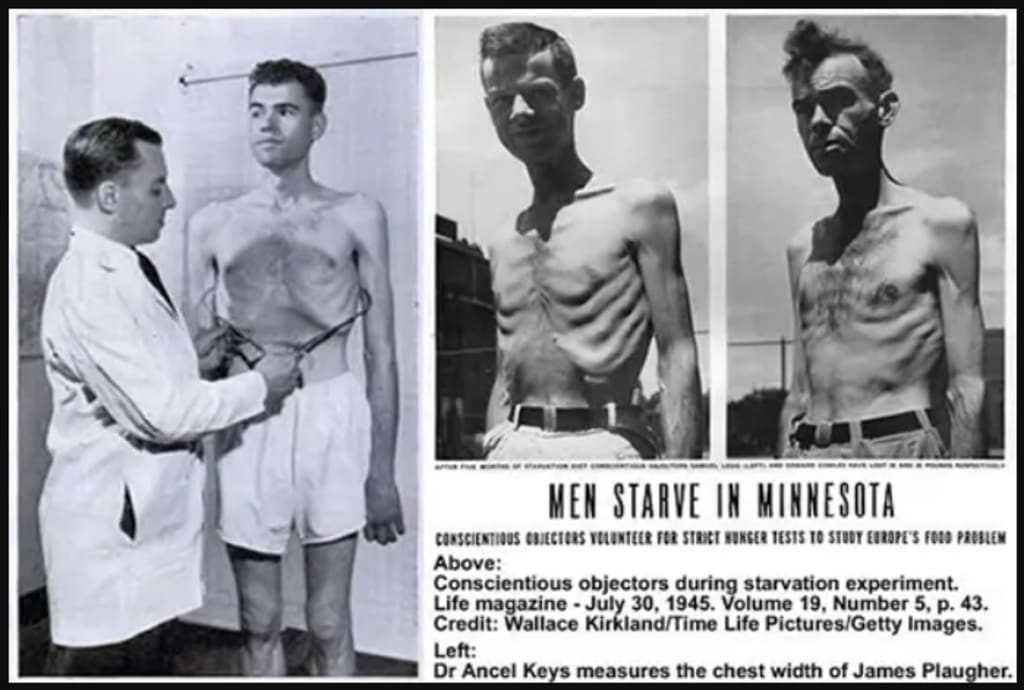
Starvation is a natural response to hunger, but what if the feeling of starvation persisted for six months? In the 1940s, a group of healthy men underwent the ultimate hunger test as part of a study conducted at the University of Minnesota. Surprisingly, the most challenging aspect of the study was not the period of starvation, but the subsequent refeeding phase. Even more disturbing were the effects on their mental state throughout the ordeal. They became utterly fixated on food to the point where it consumed their every thought. Some even descended into insanity, and one volunteer even harmed himself because he could no longer bear it. All of this was done in the name of aiding the millions of people who unwillingly starve during war.
The experiment was conducted during World War II, where people all over Europe were starving. The U.S military wanted to find the best way to refeed them, so an experiment was conducted with the reason painted as the volunteers starved so that others will be better fed. At the time, there was limited scientific knowledge about how to rehabilitate individuals who suffered from severe malnutrition. Ansel Keys and his colleagues proposed a bold human experiment subjecting volunteers to semi-starvation and then refeeding them for the study to push through. The first thing Keys needed were participants, but how do you get volunteers to participate in being hungry all the time? Surprisingly, the answer was as simple as setting out brochures with a thought-provoking question: "Will you starve so that others may be better fed?" This appeal resonated particularly with conscientious objectors, men who refused to take part in the war on the grounds of conscience. For them, it provided an alternative way to contribute without bearing arms. In the end, 36 able-bodied men were chosen from a pool of conscientious objectors.
The study had five phases in total, each lasting 12 weeks. In the first phase, the 36 men underwent a three-month period of normal eating. This phase served as the baseline to establish their normal physical and mental state. They were given the same diet but were suited according to their body requirements. At this phase, the staff measured every part of their body imaginable, such as weight, height, stomach size, eyesight, hand-eye coordination, bone density, and lung capacity. Samples were also taken, such as urine, stool, sperm, and bone marrow. Their usual mood and personality were taken note of as well.
During the following six months, the phase of semi-starvation began, marking the start of the experiment's true horrors. They were only given two meals a day out of three different menus. The meals they were given were cycled each day and started over again once they finished each cycle. The menus were designed to be monotonous and similar to the food found in central European countries during famine, which consisted of whole wheat bread, potatoes, cereals, turnips, and cabbages. A small amount of dairy and meat were also added. Approximately half of their caloric needs were cut off from their meals during the entirety of this period. The goal of this was to simulate famine, which was faced by the people during the war. In the first few weeks, they still had a bit of energy to go along with their team, but gradually, the simplest task became too much for them. Walking a flight of stairs became impossible without taking a break or two. Sitting straight became a pain, so they had to bring pillows everywhere they went to act as a cushion. To add to their physical strain, they were also expected to walk approximately 22 miles and spend half an hour on a treadmill each week. It became too much for them that they would run to the point of collapse. All they wanted to do was lie down in the sun and wait for the six months to be over.
The men's obsession over food have also muted their desire for women. While some of the men continued to pursue romantic relationships, in reality, none of them truly felt any interest in them. The ones who maintained their dating life were, in reality, competing with one another of who can date the longest. Sometimes they would go watch a movie, but comedic scenes were no longer funny, and love scenes were boring. The parts that involve people eating were the best for them. When it was mealtime, each and every one of them had their way of savoring their food. Some chose to eat it as quickly as they could and not have to think about it, while others chose to eat it as slow as possible, savoring each bite. Remember how the food was designed to be monotonous? Well, the volunteers didn't really care whether or not it was monotonous, as long as it was food. Everything tasted delicious. One of the volunteers even said, "Even the dirty crust of bread in the street looked appetizing, and we envied the fat."
About the Creator
PDZICOX
Everyday articles.
The information on this page will help you learn more about mystery, news, facts, psychology, geography and more. We will provide the best resources for learning about these topics.






Comments
There are no comments for this story
Be the first to respond and start the conversation.